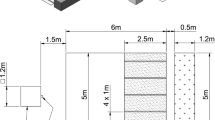Summary
-
1.
The escape response of the cockroachPeriplaneta americana to the predatory strike of the toadBufo marinus was studied by cinematography and stop-frame analysis. Various manipulations permitted us to appraise the role of the turning behavior mediated by the cereal wind receptors (Camhi and Tom, 1978) in the escape from toads.
-
2.
Cockroaches with their cerci covered showed fewer successful escapes from toad strikes than did either normal cockroaches or those with their sternites covered as a control (Table 1).
-
3.
The cockroach's escape behavior was similar to its behavioral response to wind puffs (Camhi and Tom, 1978). Similarities included an initial pivot away from the toad (Figs. 1 and 2) and similar initial movements of the metathoracic legs.
-
4.
The displacement of air produced by a toad's strike was recordable at the position of the cockroach throughout essentially the entire strike. If wind were the only cue by which the cockroach responded to the toad, the cockroach must have received a supra-threshold wind stimulus at an average time of 75 ms before the toad's tongue appeared. This calculation is the sum of the average time during the strike when the cockroach began its escape movements (17 ms before the toad's tongue appeared [Fig. 4]), and the mean latency of the escape response to wind puffs (58 ms [Roeder, 1963; Camhi and Tom, 1978]). Therefore, the mean wind speed at 75 ms before the toad's tongue appeared should represent an adequate stimulus to evoke the escape behavior. The mean wind speed at this time was 22 mm/s.
-
5.
Controlled wind puffs directed at the cerci of restrained cockroaches evoked escape movements of the legs. The mean value of the peak wind speed of a just supra-threshold puff was only 1–5 mm/s.
-
6.
Visual, auditory, vibrational and olfactory cues from the toad, in the absence of wind, did not evoke escape behavior.
-
7.
These results suggest that the extreme sensitivity of the cockroach's wind-detecting system permits the use of wind as a major channel of information for detecting predators under semi-natural conditions.
-
8.
These findings are discussed with reference to (a) the problems this detection system might encounter in a natural environment (b) implications for the neural control of escape behavior in the cockroach, and (c) comparative aspects of escape behavior in different animals.
Similar content being viewed by others
References
Allen, L., Leman, E., Muller, L.: Environment of a Costa Rican rain forest. Ecology53, 102–111 (1972)
Camhi, J., Tom, W.: The escape behavior of the cockroachPeriplaneta americana. I. Turning response to wind puffs. J. comp. Physiol.128, 193–201 (1978)
Dean, J.: Predator prey interactions between toads and bombardier beetles: a behavioral and neurophysiological study. Ph. D. thesis, Cornell University, Ithaca, New York (1977)
Markl, H., Tautz, J.: The sensitivity of hair receptors in caterpillars ofBarathra brassicae L. (Lepidoptera, Noctuidae) to particle movement in a sound field. J. comp. Physiol.99, 79–87 (1975)
Ritzmann, R.E., Camhi, J.M.: Excitation of leg motor neurons by giant interneurons in the cockroachPeriplaneta americana. J. comp. Physiol.125, 305–316 (1978)
Roeder, K.: Nerve cells and insect behavior. Cambridge, Massachusetts: Harvard University Press 1963
Roth, L., Willis, E.: The biotic associations of cockroaches. Smithsonian Mesc. Coll.141 (1960)
Tautz, J.: Reception of medium vibration by thoracal hairs of caterpillars ofBarathra brassicae L. (Lepidoptera, Noctuidae) I. Mechanical properties of the receptor hairs. J. comp. Physiol.118, 13–31 (1971)
Westin, J., Langberg, J., Camhi, J.: Responses of giant interneurons of the cockroachPeriplaneta americana to wind puffs of different directions and velocities. J. comp. Physiol.121, 307–324 (1977)
Wine, J.J., Krasne, F.B.: Organization of escape behaviour in the crayfish. J. Exp. Biol.56, 1–18 (1972)
Author information
Authors and Affiliations
Additional information
We thank D. Knaack for helping with the threshold determinations, and Drs. R. Ritzmann, E. Sherman and J. Westin for helpful comments on the manuscript; Dr. Z. Warhaft for aerodynamic advice; and Dr. R. Capranica for the use of theBufo marinus. This research was supported by NIH grant NS 09083.
Rights and permissions
About this article
Cite this article
Camhi, J.M., Tom, W. & Volman, S. The escape behavior of the cockroachPeriplaneta americana . J. Comp. Physiol. 128, 203–212 (1978). https://doi.org/10.1007/BF00656853
Accepted:
Issue Date:
DOI: https://doi.org/10.1007/BF00656853




